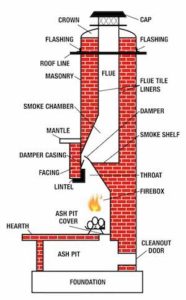Chimney Health Hazards: Things You Should Know
The chimneys along with the fireplaces provide us warmth during cold days. They can however, have several ill-effects on our health. Of course, no one should live under fear and take timely steps for chimney cleaning to stay away from chimney and fireplace health hazards. Read on some of the ways that affects our health.
Creosote Exposure
Creosote is an oily black substance that builds up in chimney flue interiors due to incomplete wood combustion. This not only seems nasty but leads to undesirable side effects on our health:
- Skin or Eye irritation: Any form of contact with creosote buildup leads to skin rashes and irritation in eyes. In some cases, it leads to extreme burning sensation with increased chances of sensitivity to light.
- Respiratory Issues: Even indirect inhalation of creosote particles for extended period leads to lung or respiratory problems.
- Abdominal or Mental Problems: Creosote increases the chances to affect kidney or liver and gives rise to abdominal problems. Prolonged creosote exposure causes seizures and confusion to the affected people.
- Cancer: Although, regular chimney inspection and cleaning minimizes the chances of ill-effects of creosote but creosote exposure always increases the chances of skin cancer.
Chimney Soot Inhalation
Chimney soot is source of contamination that comes from incomplete combustion and formed when wood burns at less than 284 degrees and not burned hot enough. The left-over in the form of powdery brown or black dust sticks to the chimney interiors and escapes into the air leads to other serious health risks:
- Lung Hazard: The excessive inhalation of chimney soot can cause lung irritation or serious lung diseases.
- Respiratory Risks: Chimney soot also increases the chances of general respiratory infections.
Carbon Monoxide Poisoning
The incomplete combustion due to lack of oxygen to finish oxidation process leads to formation of carbon monoxide. This is a hazardous gas and its odorless and colorless properties make it arrant hard to detect. Contact a chimney contractor for regular inspection as when carbon monoxide enters into the air, various health issues may emerge:
- Flu-like Symptoms: Even inhaling small amounts of carbon monoxide leads to fatigue, confusion, nausea or headache.
- Organ Issues: The excessive inhalation of carbon monoxide worsens the effects on your health. Breathing in this gas might lead to brain damage or heart problems, and at its worst it can even cause death.
None of these risks are enjoyable to deal. Ignoring chimney cleaning gives rise to many health hazards. So, the underlying message is to take precautions and clean your chimney regularly. Chimney sweeping inspect the internal structures of the damage and remove creosote, soot and other chimney deposits thus reducing the health risks. Make sure to get your chimney detected for carbon monoxide and install a detector for the same. A better knowledge of chimney risks and timely fireplace repair make you enjoys wintertime fires in a responsible way.
The post Chimney Health Hazards: Things You Should Know first appeared on First Class Chimney Services Maryland.
This post first appeared on https://www.firstclasschimneyservices.com



 Parts of the Chimney
Parts of the Chimney